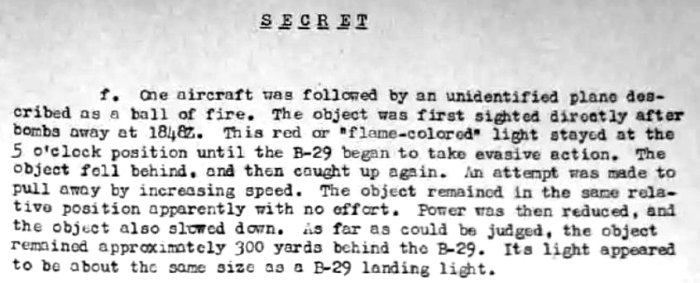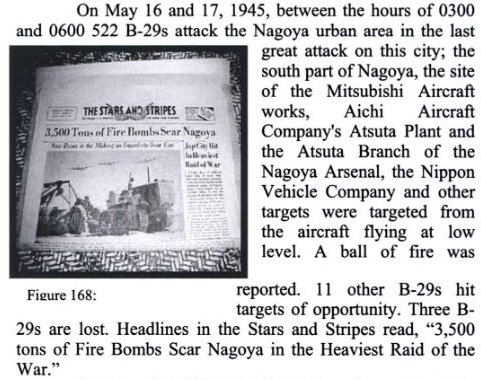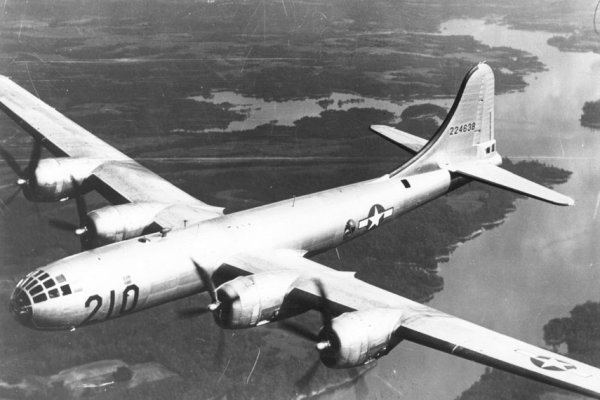ACUFO-1945-05-17-NAGOYA-1
In the report of the XXIst Bomber Command Tactical Mission No. 176, flown by the B-29's bombers of the 58th, 73rd, 313th and 134th Bombardment Wings on May 16-17, 1945, the target being the Mitsubishi Aircraft Works at the South of the Nagoya Urban Area, Japan, there was a section about encounters of “balls of fire” by the airmen, as opposed to enemy planes, flak and other mundane observations.
Among these observations of “Unusual Types” and “balls of fire”, we find that...
... One aircraft was followed by an unidentified plane described as a ball of fire. The object was first sighted directly after bombs away at 1848Z. This red or “flame-colored” light stayed at the 5 o'clock position until the B-29 began to take evasive action. The object fell behind, and then caught up again. An attempt was made to pull away by increasing speed. The object remained ln the same relative position apparently with no effort. Power was then reduced, and the object also slowed down. As far as could be judged, the object remained approximately 300 yards behind the B-29. Its light appeared to be about the same size as a B-29 landing light.
| Date: | May 17, 1945 |
|---|---|
| Time: | 04:48 a.m. |
| Duration: | |
| First known report date: | May 17, 1945 |
| Reporting delay: | Hours. |
| Country: | Japan |
|---|---|
| State/Department: | Aichi |
| City or place: | Nagoya |
| Number of alleged witnesses: | 2 or more. |
|---|---|
| Number of known witnesses: | ? |
| Number of named witnesses: | 0 |
| Reporting channel: | Military operations report. |
|---|---|
| Visibility conditions: | Night. |
| UFO observed: | Yes. |
| UFO arrival observed: | Yes. |
| UFO departure observed: | Yes. |
| UFO action: | Approaches, follows, goes away. |
| Witnesses action: | Escape maneuvers. |
| Photographs: | No. |
| Sketch(s) by witness(es): | No. |
| Sketch(es) approved by witness(es): | No. |
| Witness(es) feelings: | ? |
| Witnesses interpretation: | ? |
| Sensors: |
[X] Visual: 2 or more.
[ ] Airborne radar: [ ] Directional ground radar: [ ] Height finder ground radar: [ ] Photo: [ ] Film/video: [ ] EM Effects: [ ] Failures: [ ] Damages: |
|---|---|
| Hynek: | NL |
| Armed / unarmed: | Armed, 12 Browning M2 12.7 mm machine guns. |
| Reliability 1-3: | 3 |
| Strangeness 1-3: | 2 |
| ACUFO: | Possible extraterrestrial craft. |
[Ref. aaf1:] U.S. ARMY AIR FORCES:
This report was of the XXIst Bomber Command Tactical Mission No. 176, flown 16-17 May 1945, the target being the Mitsubishi Aircraft Works at the South of the Nagoya Urban Area, Japan.
The units involved were the 58th, 73rd, 313th and 134th Bombardment Wings. The initial point (IP) was at Biwa Lake, landfall was at O Shine.
The report below appeared in the “Enemy Air Opposition” part of the report. This part included information about the enemy aircraft encountered during the mission and what these did.
But in this “Enemy Air Opposition” part, there was also a section titled “Observations of Unusual Types”, followed by a section “Balls of fire”, in which several observation of what was thought to be other things than planes, rockets, flares and flak, appeared. It included:

|
S E C R E T
f. One aircraft was followed by an unidentified plane described as a ball of fire. The object was first sighted directly after bombs away at 1848Z. This red or “flame-colored” light stayed at the 5 o'clock position until the B-29 began to take evasive action. The object fell behind, and then caught up again. An attempt was made to pull away by increasing speed. The object remained ln the same relative position apparently with no effort. Power was then reduced, and the object also slowed down. As far as could be judged, the object remained approximately 300 yards behind the B-29. Its light appeared to be about the same size as a B-29 landing light.
[Ref. prt4:] JAN ALDRICH - "PROJECT 1947":
N - 1945.05.15 - Night, Nogoya [sic], Japan.
B-29, 444th Bomb Group, “The first sighting of a ball of fire was made on this mission.” (444th Bombardment Group history)
[Ref. fge1:] FRANK L. GRUBE:

|
On May 16 and 17, 1945, between the hours of 0300 and 0600 522 B-29s attack the Nagoya urban area in the last great attack on this city; the south part of Nagoya, the site of the Mitsubishi Aircraft works, Aichi Aircraft Company's Atsuta Plant and the Atsuta Branch of the Nagoya Arsenal, the Nippon Vehicle Company and other targets were targeted from the aircraft flying at low level. A ball of fire was reported. 11 other B-29s hit targets of opportunity. Three B- 29s are lost. Headlines in the Stars and Stripes read, “3,500 tons of Fire Bombs Scar Nagoya in the Heaviest Raid of the War.”
[Ref. dwn1:] DOMINIQUE WEINSTEIN:
At night, the pilot of a USAAF B-29 (444th Bomb Group) saw one ball of fire, “The first sighting of a ball of fire” was made on this mission.
Sources: Project 1947, Jan Aldrich / 444th Bombardment Group History
The Boeing B-29 “Superfortress” was the heaviest bomber of the U.S. Army Air Forces, used in operations from May 8, 1944 and on. Its maximum speed was 574 km/h.
Its defensive armament was 12 Browning M2 12.7 mm machine guns.

|
[Ref. dwn2:] DOMINIQUE WEINSTEIN:
At night, the pilot of a USAAF B-29 (58th Bombardment Wing / 444th Bomb Group) saw one ball of fire, “the first sighting of a ball of fire” was made on this mission. According to the 58th Bombardment Wing's Tactical Mission Report: “Aircraft 4861 was followed by an unidentified plane described as a ball of fire. The object was first observed directly after bombs away at 18h48 Z. This red or “flame colored” light stayed at the five o'clock position until the B-29 began to take evasive action. The object fell behind, and then caught up again. An attempt was made to pull away and speed was increased. The object stayed in the same relative position apparently with no effort. Power was then reduced, and the object also slowed down. As far a could be judged, the object stayed approximately 300 yards behind the B-29; Its light appeared to be about the same size as a B-29 landing light.”
Sources: Project 1947, Jan Aldrich / 444th Bombardment Group History / HQ 58th Bombardment Wing, Mission information, 16 May 1945 / HQ XXI Bomber Command, APO 234, 8 July 1945, Subject: Report of operations 16-17 May 1945 to the Commanding General 20th Air Force, Washington DC, NARA / Strange Company: Military encounters with UFOs in WWII, Keith Chester, 2007
[Ref. sua1:] WEBSITE "SATURDAY NIGHT UFORIA":
One of the reports Chamberlin refers to [in his famous American Legion article] may have been from the night of May 14, 1945, on a mission targeting Nagoya, as told in another Tactical Mission Report...
A/C 4861 was followed by an unidentified plane described as a ball of fire. The object was first sighted directly after bombs away at 1848Z. This red or "flame colored" light stayed at the five o'clock position until the B-29 began to take evasive action. The object fell behind, and then caught up again. An attempt was made to pull away and speed was increased. The object stayed in the same relative position apparently with no effort. Power was then reduced, and the object also slowed down. As far as could be judged, the object stayed approximately 300 yards behind the B-29. Its light appeared to be about the same size as a B-29 landing light.
[Ref. tai1:] "THINK ABOUT IT" WEBSITE:
Date: May 14, 1945
Location: Nagoya, Japan
Time:
Summary: Red or flame-colored light, constant position, same size as B-29 landing light
Source:
(Ref. nip1:) "THE NICAP WEBSITE":
May 14, 1945; Nagoya, Japan
Red or flame-colored light, constant position, same size as B-29 landing light. (Page 166 Ref.1)
The reference 1 is described at the end of the document as "Strange Company (2007), Keith Chester".

|
During World War II, the 444th Bombardment Group (Very Heavy) of the United States Air Forces was the first Boeing B-29 “Superfortress” Group formed for the 58th Bombardment Wing, and served in the China, Burma, India, and Pacific Ocean Theater as part of the XXth Air Force. The group's aircraft engaged in very heavy bombardment operations against Japan. The group received the Distinguished Unit Citation for its combat operations on three occasions.
Historical sources confirm two the 444th bombed Nagoya in May 1945.
MAY 14, 1945 .. ... ... NAGOYA, JAPAN ... 3059 miles ...
28 aircraft hit primary target ... daylight mission at 17,000 feet ...
581 incendiary clusters on target ... results were fair.MAY 16, 1945 ........ NAGOYA, JAPAN ... 3092 miles ...
27 aircraft hit primary target ... night mission at 13,600 feet ...
852 incendiary clusters on target ... results were 13.7 7<; new damage.
The above is from “The pictorial history of the 444th Bombardment Group, very heavy special” (1947). World War Regimental Histories, at http://digicom.bpl.lib.me.us/ww_reg_his/128
Interestingly maybe, at 21, Edward J. Ruppelt, of Grundy Center, Iowa, entered combat on December 14, 1944, as a member of 677th Squadron of the 444th Bombardment Group when it was based in India.
Ruppelt was then a bombardier, posted in the nose of a B-29 “Superfortress”. In May, 1944, Ruppelt was based on Tinian Island, between May and August, 1944, he flew 18 missions against Japan, including two against Nagoya. He ranked First Lieutenant, and flew his last mission on August 11, 1945, bombing the Hikari naval arsenal at Tokuyama, Japan.
After WWII, Edward J. Ruppelt was an aeronautical engineer in the Foreign Technology Department of the Air Technical Intelligence Center of the US Air Forces at Dayton, Ohio, leading a team in charge of analyzing the Soviet jet fighter MiG-15, ranking Captain; he was interested in the “flying saucers” reported in the military, and in 1951, he was appointed new head of the US Air Forces investigations of “flying saucers” reports; which he soon renamed “Unidentified Flying Objects” reports. The project started as “New Project Grudge” but was soon renamed “Project Blue Book.”
I found no writing by Ruppelt about any sighting of a ball of fire by 444th Bombardment Group; but is is very possible that he heard about it, or about other sightings of the Pacific theater in 1944 - 1945.
In the 2000s, ufological sources recorded numerous observations, neither more nor less strange, coming from reports of bombing missions on Japan by the XXIst Bomber Command; but this one does not seem to have been found.
It is obviously not entirely possible to completely exclude that it was an enemy plane. But the sighting was not considered as such in the report, being noted in a section regarding “balls of fire” instead of the section regarding enemy aircraft.
Sometimes, crews thought they encountered “Baka” rocket planes, and they sometimes did; in this case the description does not fit. The Baka rocket exhaust was always described with terms such as “3 feet wide and 15 feet long”, and always at the rear of the Baka.
This observation shows several typical characteristics of what has been called the “Foo-Fighters”: the following maneuvers of the plane despite the escape maneuvers of the plane, and the absence of attack by the ball of fire.
In the present case, we can of course exclude a rocket, an air-air bomb, a balloon, a meteor, a searchlight, a flare, etc. The only “ordinary” explanation which would be “the least worst” remains that of an enemy plane. But the behavior does not correspond to this, the ball of fire remaining within firing range of the B-29's machine guns, which would be madness on the part of a Japanese pilot. We also note that as the ball of fire does not fire any shots, the B-29 probably did not fire either, because if it had done this it would have been noted in the report, with the result.
Unfortunately we don't have enough information here for a firm conclusion. The affair even gives rise to the idea that this may have been an astronomical mistake, with the remark “The object remained in the same relative position apparently without effort. The power was then reduced, and the object also slowed down.”
The time is given as “1848Z”, in local time this is 04:48 a.m. the day after May 15, 1945, which puts the case at May 16, 1945, which corresponds well to the bombing of May 16, 1945, which I found in historical sources.
At this time towards Nagoya, Venus was at 95°, elevation 20° 58'; Mars was not far away; Jupiter was below the horizon.
There are problems with such an explanation. First, half of the solar disk was already above the horizon; it was almost daytime. Worse, the sun was in the 66° direction, only 30° to the left of Venus and Mars, and its brightness would hardly have allowed Venus or Mars to be distinguished.
Finally, Venus and Mars were straight south, while the B-29 was on its way back. The report clearly indicates that the “ball of fire” followed the plane, while Venus and Mars would have been in front of the plane.
These reasons therefore make me reject this explanation.
The strangeness of the “ball of fire” is not absolutely obvious, and an enemy aircraft with a projector on the nose cannot be entirely ruled out.
But on the other hand, the gunners in the crew did not open fire, even though they thought that the “ball of fire” was at only 300 meters. In other words, for them, it was not an enemy plane.
Possible extraterrestrial craft.
* = Source is available to me.
? = Source I am told about but could not get so far. Help needed.
| Main author: | Patrick Gross |
|---|---|
| Contributors: | None |
| Reviewers: | None |
| Editor: | Patrick Gross |
| Version: | Create/changed by: | Date: | Description: |
|---|---|---|---|
| 0.1 | Patrick Gross | December 20, 2023 | Creation, [aaf1]. |
| 1.0 | Patrick Gross | December 20, 2023 | First published. |
| 1.1 | Patrick Gross | April 26, 2024 | Additions [prt4], [fge1], [dwn1], [dwn2], [tai1]. |
| 1.2 | Patrick Gross | June 16, 2024 | Addition [sua1]. |
| 1.3 | Patrick Gross | June 29, 2024 | Addition [nip1]. |